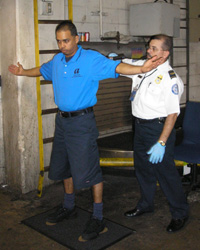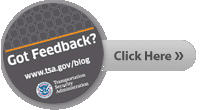Can someone explain why there are so many different lines to a checkpoint?
 Black/Blue/Green, First Class, Premier, Red Carpet-it seems like there are 18 different types of lines leading to a TSA checkpoint and only one for the "regular" traveler. What's the deal?
Black/Blue/Green, First Class, Premier, Red Carpet-it seems like there are 18 different types of lines leading to a TSA checkpoint and only one for the "regular" traveler. What's the deal?Well, there's the history and then there's where we're going.
Historically, TSA hasn't taken ownership over the security queue. This dates back to pre-9/11 and pre-TSA when airlines contracted with security companies to man checkpoints. Instead of taking control of the queues after 9/11 when we were established, we have relied upon the airport operator and the airlines to manage the queue for us so we could concentrate directly on screening passengers. This originally included checking passenger identification and boarding passes to ensure that only ticketed passengers were entering the queue and going through security. In general, TSA took the view that once you got to security, we treated everyone the same. Passengers may have progressed through the queue at a different speed, but they fed into the same security lines in the checkpoint itself.
In terms of real estate, the queue is not generally considered to be a part of the checkpoint. It's a part of the airport lobby where the line for people to enter into the checkpoint is setup. The actual screening takes place in the actual checkpoint. As a result, since it belonged to the airport, the airport operator and airline tenant were allowed to do what they wanted with it so long as everyone went through the checkpoint before they boarded their flight. Enter premium passenger lanes-without revenue coming to TSA. It was airport space, and we let the airport manage it.
Now for the Checkpoint Evolution view.
The first thing that our research on Checkpoint Evolution told us is that in terms of the passenger experience, the queue belongs to TSA-not entirely new to us, but something of which we should take more notice. We've tracked queue wait times for a long time; however, that data is used to make sure our airports are properly resourced, and our research has told us that the queue experience also has a critical element of which we needed to take notice. For example, inexperienced travelers and families feel like they need more time to prepare for screening, want more help with the process, and do not like being in the queue in front of a Road-Warrior traveler, tapping their foot, who doesn't really care about the queue experience as long as it moves quickly. (Road-Warriors can be irritated with the families and the slower travelers, but it's their lack of speed and not the fact they're a family that bothers them.)
So, we started looking for ways to put our research to good use with two goals in mind. First, we wanted to build a new environment that would make our behavioral observation programs more effective by helping to reduce the overall stress in the queue and the checkpoint. Second, we wanted to find a way to increase our efficiency and reduce x-ray alarm rates by allowing the fast passengers to move fast, and the slow passengers to take their time. End result - the "Black Diamond" pilot in Salt Lake City that joined the queue to the checkpoint and allowed passengers to pick a security line designed to meet their needs and let them move at their own pace (keeping Road-Warriors and the Families separate for the whole screening experience). For those new to the blog, "Black Diamond" was named after the ski logos that help snow skiers choose ski trails based on their level of difficulty.
The results were tremendously positive-especially with passengers who wanted an experience where they could take their time going through security. The queue and the security experience were much calmer for passengers, and our initial results show that the new multi-queue "Black Diamond" checkpoints are more efficient than regular checkpoints. We're now 20 airports later, and we're still seeing the same results. As a matter of fact, peak wait times at Salt Lake City this past Memorial Day weekend were about half as along as they were last year, even though the number of passengers going through the checkpoint actually went up by about 5 percent.
It's important to note that even under this new system, the queue still sits on airport real estate, so "Black Diamond" is only coming to a willing airport near you. TSA can't force an airport into a particular queue design-although more than a few airports are interested in the project. Security is a partnership between TSA, airport operators, airlines, and passengers, and TSA is looking to work with all comers. We're thankful for those airport operators who have been willing to experiment with us to build a better queue management mousetrap, but we also understand that airports have other needs, and even this project might not work everywhere.
Diamond lanes, family lanes, Elite lanes, whatever lanes, they all add up to a better experience for passengers and a safer environment for everyone.
Matt
EoS Blog Contributor
Labels: mission

 A millimeter wave machine looks like this:
A millimeter wave machine looks like this:

















